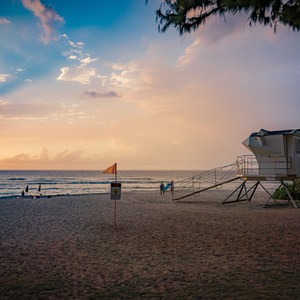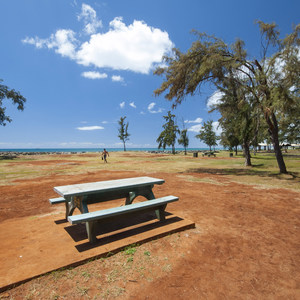You are here
The world-famous Waimea Bay has a massive, wide stretch of white sandy beach, a large river feeding into the sea, a huge rock for cliff diving, a giant beach park, the nearby botanical garden and waterfall, and a ton of local history, making this one of the North Shore's must-see destinations.
Waimea is considered the birthplace of big-wave surfing, and it was during the late 1950s that a Californian named Greg Noll and others decided that the giant winter waves of O'ahu's North Shore might actually be ridden on newly designed surfboards. In November of 1957 he became famous when he surfed 25- to 30-foot waves at this beach in his iconic black and white trunks, a feat that even the local Hawaiians thought was impossible.
Nowadays there are hundreds of professional big-wave surfers who use jet skis to get themselves in the right position or out of the wrong one, and it is amazing to imagine Noll and his buddies riding these waves with minimal technology. Along with the beach, the history, and the waves, visitors will also find the famous "jump rock," a large volcanic outcrop that sits right at the shoreline and makes for a perfect diving platform. Locals and tourists spend all day climbing up and jumping down into the incoming shore break.
Waimea is home to the Eddie Aikau Surf Competition, which is only held when the waves are over 30 feet tall. The competition has only had the right conditions eight times in the last 24 years and is considered the most elusive of all surfing prizes. Aikau is one of the most famous Hawaiians of all time, and he is known as the first man willing to lifeguard at the North Shore. He never lost a life on the job, but he did lose his own when he risked certain death in a desperate attempt to save the crew of the capsized Hokulea. Attempting to paddle back to O'ahu for help, he was never seen again, but he will never be forgotten by the local people.
Waimea means "reddish water," a phenomenon caused by the Waimea River, which carries oxide-rich soil from the valley above into the ocean below. The beach is large and wide, but the shore break is often very dangerous. On flat days you can play in the water safely, but watch for the signs that tell you when you are not allowed to enter the water. Nearby Hale'iwa is a perfect place to grab some food or shave ice at Matsumoto's famous heat relieving stop.











Comments
Sign In and share them.